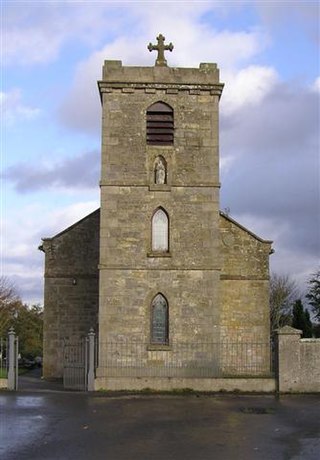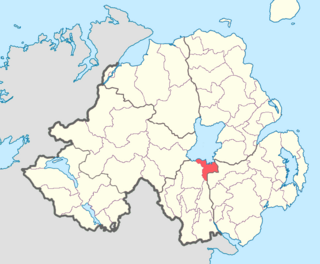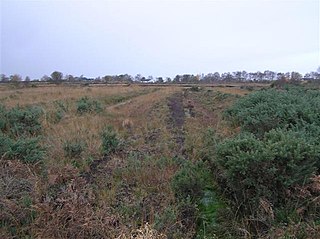
County Antrim is one of six counties of Northern Ireland and one of the thirty-two counties of Ireland. Adjoined to the north-east shore of Lough Neagh, the county covers an area of 3,086 square kilometres (1,192 sq mi) and has a population of about 618,000. County Antrim has a population density of 203 people per square kilometre or 526 people per square mile. It is also one of the thirty-two traditional counties of Ireland, as well as part of the historic province of Ulster.
Lurgan is a town in County Armagh, Northern Ireland, near the southern shore of Lough Neagh. Lurgan is about 18 miles (29 km) south-west of Belfast and is linked to the city by both the M1 motorway and the Belfast–Dublin railway line. It had a population of about 31,000 at the 2021 UK census and is within the Armagh, Banbridge and Craigavon district. For some purposes, Lurgan is treated as part of the "Craigavon Urban Area" along with neighbouring Craigavon and Portadown.

Craigavon is a town in northern County Armagh, Northern Ireland. Its construction began in 1965 and it was named after the first Prime Minister of Northern Ireland: James Craig, 1st Viscount Craigavon. It was intended to be the heart of a new linear city incorporating Lurgan and Portadown, but this plan was mostly abandoned and later described as having been flawed. Among local people today, "Craigavon" refers to the area between the two towns. It is built beside a pair of artificial lakes and is made up of a large residential area (Brownlow), a second smaller one (Mandeville), plus a central area (Highfield) that includes a substantial shopping centre, a courthouse and the district council headquarters. The area around the lakes is a public park and wildlife haven made up of woodland with walking trails. There is also a watersports centre, golf course and ski slope in the area. In most of Craigavon, motor vehicles are completely separated from pedestrians, and roundabouts are used extensively. It hosted the headquarters of the former Craigavon Borough Council.

Lough Neagh is a freshwater lake in Northern Ireland and is the largest lake in the island of Ireland, the United Kingdom and the British Isles. It has a surface area of 151 square miles and supplies 40% of Northern Ireland's water. Its main inflows come from the Upper River Bann and River Blackwater, and its main outflow is the Lower River Bann. Its name comes from Irish Loch nEachach[ˌl̪ˠɔx ˈn̠ʲahəx], meaning "Eachaidh's lake". The lough is owned by the Earl of Shaftesbury and managed by Lough Neagh Partnership Ltd.
Donegore is the name of a hill, a townland, a small cluster of residences, and a civil parish in the historic barony of Antrim Upper, County Antrim, Northern Ireland. Donegore lies approximately 5 miles (8 km) east of Antrim town. 154 acres of the townland lies in the civil parish of Grange of Nilteen.

Maghery is a small village and townland in County Armagh, Northern Ireland. It lies on the southwest shore of Lough Neagh, near Derrywarragh Island, in the northwest corner of the county. As it sits between the estuaries of the rivers Blackwater and Bann, Maghery was of strategic significance in the past.

Lower Ballinderry is a small village to the west of Upper Ballinderry in County Antrim, Northern Ireland. It is within the townland and civil parish of Ballinderry and the historic barony of Massereene Upper. The village lies a short distance to the southeast of Portmore Lough and Lough Neagh, 12 kilometres (7.5 mi) west of Lisburn. In the 2001 census it had a population of 441.
Ballymaguigan is a hamlet and townland in County Londonderry, Northern Ireland. It is near the northwest shore of Lough Neagh and close to Magherafelt. The hamlet forms one part of a parish named Ardtrea North. Ballymaguigan is part of the Mid-Ulster District.

Ballyronan is a village and townland in County Londonderry, Northern Ireland, on the north western shore of Lough Neagh. The village is 5 miles (8 km) from Magherafelt and 12 miles (19 km) from Cookstown. It is situated within Mid-Ulster District.

Ardboe is a large parish civil parish in east County Tyrone, Northern Ireland. It borders the western shore of Lough Neagh and lies within the Mid Ulster District Council area. It is also the name of the local civil parish, which incorporates both Mullinahoe and Moortown.
Ballinderry is a small civil and ecclesiastical parish on both sides of the County Londonderry / County Tyrone border in Northern Ireland. It is a rural parish of about 350 houses and lies on the western shores of Lough Neagh.

Ballylifford is a townland in County Londonderry, Northern Ireland. It is within the civil parish of Ballinderry, on the western shores of Lough Neagh, and is part of Mid-Ulster District. Many of the houses in the area have been built along Ballinderry Bridge Road.

Derrytresk is a townland outside Coalisland, County Tyrone, Northern Ireland and is close to the shores of Lough Neagh. It is situated in the historic barony of Dungannon Middle and the civil parish of Clonoe and covers an area of 1020 acres. Derrytresk consists of sub-townlands: Derryvarne, Derrykiltena and Derrynahaskila.
Derrymore is a small village and townland in County Antrim, Northern Ireland. In the 2001 Census it had a population of 243 people. It lies on the shores of Lough Neagh, within the Armagh City, Banbridge and Craigavon Borough Council area.

Lough Beg is a small freshwater lake north of Lough Neagh in Northern Ireland. The lake is located on the border between County Londonderry and County Antrim. The Lower Bann flows into it from Lough Neagh at the southern end and continues on its route to the sea from the northern end. Church Island which is on the lake was the site of a pre-Viking monastery and during the summer it is normally reachable by foot. Due to the area's many rare plants and it being a stopping point for migrating birds the area was protected as the Lough Beg National Nature Reserve. It is one of the main Irish breeding areas for the scarce Garganey.

Oneilland East is a barony in the north-east of County Armagh, Northern Ireland. It is also called Clanbrasil. It lies in the north-east corner of the county, on the south-eastern shore of Lough Neagh and the boundary with County Down. Oneilland East is bordered by three other baronies: Oneilland West to the west; Iveagh Lower to the east; and Orior Lower to the south.

Aghacommon is a small village and townland in north County Armagh, Northern Ireland. It lies between Derrymacash, Lurgan and Craigavon. The M1 motorway and Dublin–Belfast railway line are on either side. The village covers the townlands of Aghacommon and Ballynamony. The village is often confused with its better known neighbouring townland Derrymacash.

Derryloughan is a townland in County Tyrone, Northern Ireland. It lies on the southwest corner of Lough Neagh, 4 miles from Coalisland. It is situated in the historic barony of Dungannon Middle and the civil parish of Clonoe and covers an area of 1751 acres.

Wolfe Tone Gaelic Athletic Club is a GAA club in County Armagh, Northern Ireland. It is based in the townland of Derrymacash, on the southern shore of Lough Neagh, close to Lurgan. It is part of Armagh GAA and plays at Raparee Park (Irish: Páirc na Ropairí. The club takes its name from the republican leader of the 1798 revolution, Wolfe Tone.















